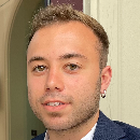Ph.D. and Post Doc
Andrea Pellegrini
Ph.D. Student
Chemical Science XXXIX Cycle
Andrea Pellegrini
received his BSc in Industrial Chemistry (cum laude) in July 2020 at the “Toso Montanari” Department, University of Bologna. During his bachelor’s internship, he carried out experimental research under the supervision of Prof. Fochi. He then obtained his MSc in Industrial Chemistry (cum laude) in July 2022 at the same department, where he worked on a computational studies of asymmetric organocatalytic reactions under the supervision of Prof. Righi. After graduating, he started a research fellowship with Prof. Mazzanti, focusing on the same topic. In 2023, he began his Ph.D. in Computational Organic Chemistry at the University of Bologna under the supervision of Prof. Mancinelli and co-supervision of Prof. Nenov, supported by a PNRR ministerial scholarship.

Nunzio Matera
PhD Student
Chemical Science XXXVIII Cycle - PNRR in collaboration with Alchemy Srl (BO)
Supervisor: Prof. Dr. Andrea Mazzanti
Co-supervisor: Dr. Michele Mancinelli
Nunzio Matera received his MSc in Chemistry (cum laude) in March 2022. During his master's project, he used Elmann's auxiliary (tBu-sulfinamide) to create new pyrrolidine organocatalysts under the supervision of Prof. A. Quintavalla and M. Lombardo. Right after graduating, he began a post-lauream internship at Alchemy S.r.l, working for third-party pharmaceutical companies to develop synthetic strategies for active pharmaceutical ingredients, API intermediates, and process impurities. In November 2022, he started a joint Ph.D. program (PNRR) with Prof. A. Mazzanti and Prof. M. Mancinelli, researching atropisomeric systems in an academic setting while maintaining a collaboration with Alchemy S.r.l.

Daniel Pecorari
PhD Student
Chemical Science XXXIV Cycle
Department of Industrial Chemistry "Toso Montanari"
Didactic Tutor
Department of Industrial Chemistry "Toso Montanari"
Academic discipline: CHIM / 06 ORGANIC CHEMISTRY
Project Thesis
Design and synthesis of new drug molecules with chiral axes (atropisomers). Characterization by mean NMR, ECD, VCD, Docking and DFT calculation.
Daniel Pecorari received his master degree in Industrial Chemistry at University of Bologna in 2017, working on the syntheses of enantioenriched heterocycle systems with prof. M. Fochi and prof. L. Bernardi. In the same year he moved to the University of Ferrara, working with Prof. A. Massi on N-heterocycle carbenes as organocatalysts for asymmetric synthesis. From 2018 he is a Ph.D. student, working with Prof. A. Mazzanti and Dr. M. Mancinelli on atropisomeric systems.
His research interests are in organic asymmetric systems, actually focused on atropisomeric drugs.
Supervisor: Prof. Dr. Andrea Mazzanti
Co-supervisor: Dr. Michele Mancinelli

Giorgiana Denisa Bisag
PhD Student- first year
Chemical Science XXXIV Cycle
Department of Industrial Chemistry "Toso Montanari"
Project Thesis
Development of new organocatalytic enantioselective methodologies
Denisa Bisag was born in 1994. She received the Master Degree in Industrial Chemistry at the University of Bologna in 2019, and she are doing a PhD in Organic Chemistry at the same institute, under the supervision of Dr. L. Bernardi and Dr M. Fochi.
Her research is now focused on two main topic: the development of axial chirality compounds exploiting a central-to-axial chirality conversion approach and the study of sulfoxonium ylides for the synthesis of heterocycles and β,β-disubstituted carbonyl compounds. Hers work is focused on the development of organocatalytic methodologies aimed to obtain enantioenriched compound in good yields under mild reaction condition.
Supervisor: Prof. Dr. Luca Bernardi
Co-supervisor: Prof. Dr. Mariafrancesca Fochi

Giulio Bertuzzi
Ph.D. Graduate in 2019
Chemical Science XXXI Cycle
Department of Industrial Chemistry "Toso Montanari"
Giulio Bertuzzi received his PhD Degree in Chemistry in 2019 at the “Toso Montanari” department of Industrial Chemistry, University of Bologna (Italy) under the supervision of Prof. M. Fochi and Prof. L. Bernardi. He is currently working as a Post-Doc researcher at Aarhus University (DK) under the supervision of Prof. K. A. Jørgensen. His main research interest is asymmetric organocatalysis, with a special focus on N-heterocycles chemistry, enantioenriched atropisomeric compounds and higher-order cycloadditions.
Thesis:
NOVEL ASYMMETRIC ORGANOCATALYTIC TRANSFORMATIONS: DEVELOPMENT, OPTIMIZATION AND APPLICATIONS.
Abstract
The developement of novel organocatalytic transformations is described. The elaborate mainly focuses on two catheories of organic reactions, namely azinium cations functionalizations (dearomatizations and aromatic subsititutions) and higher order cycloadditions. Particular attention has been devoted at the study and optimization of the reaction conditions and catalyst structure, in order to maximize yield and enantiopurity of the products as well as minimizing the catalyst loading and using the mildest conditions. The substrate scope of asymmetric reactions has always been thoroughly investigated to demonstrate the broad applicability of the proposed transformations, as well as the performance of synthetic elaborations illustrating the usefulness of the developed methods.
Supervisor: Prof. Dr. Mariafrancesca Fochi
Co-supervisor: Prof. Dr. Luca Bernardi
.

Daniel Antonio Aguilera
Ph.D. Graduate in 2019
European Doctoral Programme on Sustainable Industrial Chemistry (SINCHEM) http://www.sinchem.eu/
Department of Industrial Chemistry "Toso Montanari"
National School of Chemistry of Montpellier (ENSCM, France)
Daniel Antonio Aguilera obtained his PhD in Chemistry in 2019 under the frame of the European Doctoral Programme on Sustainable Industrial Chemistry (SINCHEM) at the National School of Chemistry of Montpellier (ENSCM, France) and the University of Bologna (Italy) under the supervision of Dr Nathalie Tanchoux and Prof Luca Bernardi. His research focused on the use of alginate-based materials as supports and catalysts for asymmetric reactions of interest in fine chemistry. From 2011 to 2016, he was professor in the University of the Llanos, Colombia teaching General Chemistry, Biochemistry and Physical Chemistry, he was also Director of the Department of Biology and Chemistry and Director of the Water Quality Centre. He received his BSc (2008) and MSc degree (2010) in Chemistry from the National University of Colombia. His academic interests range from heterogeneous catalysts to organocatalysis
Thesis:
Polysaccharide encapsulated catalysts: towards the sustainable production of fine chemicals
Abstract
Alginates are natural polysaccharides extracted from brown macro-algae, available in nearly unlimited amounts at very low prices. In the presence of some divalent metals or by lowering the pH, these renewable biopolymers can readily form hydrogels, solvogels and aerogels, characterized by high surface areas, good mechanical properties, tolerance to different media, and easy manageability. In the last years, alginate gels have been gradually used as supports for a varied range of active chemical species in heterogeneous catalysis and as solid acid Brønsted catalyst. In this context, the present work contributes to broaden the use of alginate gels in asymmetric heterogeneous catalysis, exploiting the peculiar features of this class of natural biomaterials. In the first part of this study, the use of alginate gel beads as supports to prepare a heterogenized version of an amino Cinchona alkaloid for asymmetric Michael addition is described. In contrast with the classical immobilization via covalent attachment in oil-derived support, our approach was the immobilization of the organocatalyst using non-covalent interactions. The results presented here demonstrate that the adsorption of a representative Lewis base organic catalyst (9-amino-9-deoxy epi-quinine, QNA) takes place with high yields onto acidic alginate gels (AGs) using a very simple and straightforward protocol. This protocol is robust and fully reproducible. The resulting chiral solvogel beads (QNA@AGs) are active as heterogeneous catalysts in the addition of aldehydes to nitroalkenes, affording the corresponding adducts in good yields and moderate to excellent diastereo- and enantio-selectivities. In these reactions, the carboxylic functions of the biopolymer act as both acidic co-catalyst and non-covalent anchoring site for the tertiary amine catalyst (as observed by IR spectroscopy). The use of heterocationic gels, derived from alkaline earth metal gels by partial proton exchange, provided materials with better mechanical properties and higher porosities, ultimately resulting in higher catalytic activities. The alginate gels were also assessed as a possible way of transfering chirality from the support to a reaction outcome. The Friedel-Crafts alkylation of nitroalkenes with indoles was selected as a model reaction to evaluate preliminarily the enantio-induction by metal Lewis alginate gels. The library of alginate gels tested is active in the benchmark reaction. The Cu and Ba- alginate gels afford good activity and the enantiomeric-induction is proved, obtaining moderate enantiomeric excesses under the optimized reaction conditions. Furthermore, these two metals allow access to both enantiomers of the products, an important aspect given that only one enantiomeric form of alginates is available. Finally, the heterogeneous nature of the catalyst is proved using Cu-alginate gels. The full recyclability is demonstrated, by showing that Cu-alginate gels can be recovered and recycled without loss of stereochemical activity for at least five reaction cycles. This work represents the first utilization of alginates, abundant and renewable biopolymers, as gel supports/media for asymmetric organocatalytic processes and the first example of induction of enantioselectivity for a C-C bonding reaction with interest in the fine chemical industry.
Supervisor: Dr. Nathalie Tanchoux
Co-supervisor: Prof. Dr. Luca Bernardi
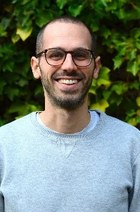
Vasco Corti
Ph.D. Graduate in 2019
Chemical Science XXXI Cycle
Department of Industrial Chemistry "Toso Montanari"
Vasco Corti earned his PhD in Chemistry in 2019 at the “Toso Montanari” department of the University of Bologna (Italy) under the supervision of Prof. L. Bernardi and Prof. M. Fochi, where he also completed his Master degree. During his PhD studies, he spent 11 months as visiting PhD student at Aarhus University joining the research group of Prof. Karl Anker Jørgensen. He is currently conducting postodoctoral studies under the supervision of Prof. K. A. Jørgensen. His research interests focus on the development of innovative enantioselective organocatalytic oxidative transformations relying on novel types of reactivity as well as the enantioselective synthesis of axially chiral products.
Thesis:
Breaking reactivity borders: engineering stereoselective reactions with organocatalytic tools
Abstract
The research focuses of my graduate education have been dealing with two main topics: the development of stereodivergent organocatalytic processes and the development of asymmetric dual-catalytic transformations. With regard to the first topic, stereodivergent processes can be defined as the synthetic sequence that allows accessing any given stereoisomers of the same product, which bears multiple stereocentres, from the same set of starting materials. The applied strategies led to the development of the first organocatalytic asymmetric example of sulfa-Michael-reductive amination synthetic sequence to access optically active 1,5-benzothiazepines, which are attractive scaffolds in the pharmaceutical field. In addition to this, thanks to a sequential catalytic approach, we developed the stereodivergent synthesis of β,β-disubstituted-α-amino acid derivatives. This protocol gives access to all the stereoisomeric forms of the desired product bearing two contiguous chiral centres. With respect to the second topic, multicatalysis strategies have emerged as powerful tool in reaction engineering. In particular, synergistic catalysis wherein two catalysts/catalytic cycles work in concert to create new bonds has attracted a great attention. With this focus in mind, we recently started to study the catalytic asymmetric [3+2] formal cycloaddition of vinylcyclopropanes and imines promoted by a palladium based metal catalyst and a chiral phosphoric acid as organocatalysts obtaining promising results in terms of reactivity and stereoselectivity. Furthermore, during my visiting period at Aarhus university, under the supervision of Prof. Karl Anker Jørgensen, I had the chance to develop the dual catalytic asymmetric oxidative γ-coupling of α,β-unsaturated aldehydes with air as the terminal oxidant obtaining the desired enantioenriched product with excellent stereoinduction and good yield values.
Supervisor: Prof. Dr. Luca Bernardi
Co-supervisor: Prof. Dr. Mariafrancesca Fochi
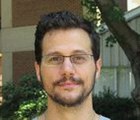
Luca Prati
Ph.D. Graduate in 2018
Chemical Science XXX Cycle
Department of Industrial Chemistry "Toso Montanari"
Thesis
Dynamic stereochemistry of chiral axes. Design and synthesis of stable atropisomers.
Abstract
In organic chemistry, dynamic processes involving the conformational exchange are ubiquitous phenomena that occur even in the simplest molecule. The study of the preferential disposition of functional groups and the definition of new interaction is therefore, of vital importance in order to foresee the spatial shape of organic molecules. In the following work, this has been accomplished by: first, an in silico DFT analysis of the conformers, second an experimental evaluation of the relative stability of the predicted conformers using the Dynamic-NMR, Dynamic-HPLC, and kinetic studies, and last the assessment of the potential absolute configuration by mean Electronic Circular Dichroism spectroscopy. The work herein reported finally aim to define the border between unstable conformations and stable ones (configurations). This border has been explored from both sides: 1) the stereodynamic side, that includes low energy process where the stereochemistry is not stable due to a low energy barrier. In this context are analysed molecules displaying long range interactions where only conformational changes are considered; 2) the stereostable side, where the energy barrier between conformers is high enough to generate distinct molecules. In this framework, the design and the synthesis of stereogenic axes in scaffold that cannot bear conventional stereogenic center are reported. This work gives a well-rounded view of the conformational analysis of organic molecules providing new insight in the interaction within stereolabile conformations as well as the generation of new stereostable conformers by the insertion of steric demanding groups.
Supervisor: Prof. Dr. Andrea Mazzanti
Co-supervisor: Dr. Michele Mancinelli
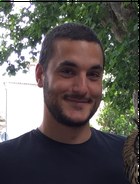
Nicola Di Iorio
Ph.D. Graduate in 2017
Chemical Science XXIX Cycle
Department of Industrial Chemistry "Toso Montanari"
Nicola Di Iorio received his MSc in Industrial Chemistry (cum laude) in 2013. During his studies at the University of Bologna he spent a year abroad at UCLA before graduation with an elaborate on the vinylogous reactivity of farmaceutically privileged compounds. Immediately after his degree he started his PhD on new organocatalytic strategies for the synthesis of chiral molecules with a particular focus on unconventional axial chirality. In 2017 he obtained his PhD, was the recipient of prices such as the “Springer theses award” or the “G.P. Spada medal award” and started a two years post-doctoral fellowship under the supervision of Proff. Paolo Righi and Giorgio Bencivenni. He is currently working in the UNIBO research office and is the referent for european projects in the “societal challenges 2” cluster in Horizon 2020.
Thesis:
New Organocatalytic Strategies for the Selective Synthesis of Centrally and Axially Chiral Molecules
Abstract
In this thesis are presented many examples of asymmetric organocatalyzed reactions. First, we discuss the vinylogous reactivity of non-symmetric 3-alkylideneoxindoles. Chiral substrates of this kind are privileged in the biological and pharmaceutical areas which is why it is important to have efficient methodologies to synthesize them, but due to their peculiar structure many possible stereochemical outcomes are available in this reaction. Therefore, the aim of this work is to simultaneously control the regio- diastereo- and enantioselectivity of the reaction of these substrates with nitroolefines and we did so using a thiourea-derived cinchona alkaloid as a bifunctional catalyst. Then we proved the reaction generality and we also gained a significant insight on the reaction mechanism performing appropriate experiments that allowed us to account for the almost complete selectivity observed. Next, we switch to axial chirality and present the desymmetrization of hindered N-aryl maleimides to generate atropisomeric succinimides. We envisioned that the crucial point of this strategy was to selectively direct the nucleophile towards only one of the electrophilic prochiral carbons of the maleimide in order to simultaneously form a stereocenter and reveal the distant chiral axis. To do so we employed different nucleophilic substrates in combination with different organocatalytic activation modes and we could demonstrate the effectiveness of this methodology obtaining the atropisomeric products in overall high yields and selectivity. The last part concerns the organocatalitic Friedel-Crafts reaction of hindered 2-naphthols with 4-substituted indenones affording an atropisomeric compound with an unconventional C(sp2)-C(sp3) chiral axis. In this reaction, the newly formed bond is itself the chiral axis and this is the very first example of such a thing realized diastereo- and enantioselectively. In summary, we show how iminium ion catalysis, promoted by cinchona alkaloid-derived primary amine, is an excellent way to perform this reaction obtaining products with complete diastereoselectivity and high enantioselectivity.
Supervisor: Prof. Dr. Paolo Righi
Co-supervisor: Prof. Dr. Giorgio Bencivenni

Asja Pettignano
PH.D. GRADUATE IN 2016
European Doctoral Programme on Sustainable Industrial Chemistry (SINCHEM) http://www.sinchem.eu/
Department of Industrial Chemistry "Toso Montanari"
National School of Chemistry of Montpellier (ENSCM, France)
Asja Pettignano earned her PhD in Chemistry in 2016 at the National School of Chemistry of Montpellier (ENSCM, France) and the University of Bologna (Italy), under the frame of the European Doctoral Programme on Sustainable Industrial Chemistry (SINCHEM). Her research, carried out under the supervision of Dr Françoise Quignard and Prof Luca Bernardi, focused on the preparation of alginate-based active materials to be employed as heterogeneous catalysts, adsorbents or self-healing gels for biomedical applications. She is currently working as a Post-Doc researcher at the National Institute of Applied Sciences of Lyon (INSA, France), under the supervision of Étienne Fleury and Aurélia Charlot. Her main research interest is the study of natural polymers, with a special focus on the use of natural polysaccharides for the development of novel materials with tailored properties.
Thesis:
Alginate : a versatile biopolymer for functional advanced materials
Abstract
Alginates, polysaccharides produced by brown algae, are linear block-copolymers formed by mannuronate (M) and guluronate (G) units. Because of their huge natural abundance, cheapness and physicochemical properties, alginates represent a highly attractive and still relatively unexplored class of biopolymers for applications in the field of advanced materials. In this context, the present work aimed to enrich the range of possible applications of alginate-derived materials, making the most of the peculiar features of this class of natural polysaccharides. In particular, the preparation of alginate-based active materials to be employed in the catalysis, adsorption and biomedical field was studied, achieving encouraging results in all the tested applications. The beneficial use of alginic acid in heterogeneous catalysis, both as reaction promoter and as support for the heterogeneization of an organocatalyst, was demonstrated. The activity of the material was found highly dependent on the accessibility of the active functions, highlighting the advantage of employing more accessible alginate formulations. The texturation of alginates was further advantageous for the preparation of materials with improved flowability. Alginic acid foams, bearing a hierarchical macro-mesoporous structure were developed by means of a simple procedure. Accurate characterization was performed to optimize the preparation procedure and to correlate the textural properties of the obtained materials with the parameters used. The interest of the prepared alginic acid foams was demonstrated in a model application, the adsorption of methylene blue from aqueous solutions, both in batch and in flow conditions. The possibility to easily modify alginate functional groups, coupled with the biocompatible and biodegradable nature of alginates, was finally employed for the development of self-healing gels, thanks to the formation of two types of dynamic covalent interactions: Schiff base and boronate ester bonds. Both the examined systems presented a marked ability to recover after damage, even if the extent of the recovery and the stability of the gels was highly dependent on the preparation parameters and environmental conditions used. The results obtained in the course of this study clearly demonstrate how a full comprehension and conscious employment of alginate physicochemical properties can maximize the potential of this sustainable resource in the field of material chemistry.
Supervisor: Dr. Françoise Quignard
Co-supervisor: Prof. Dr. Luca Bernardi
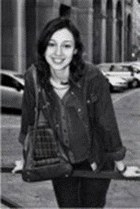
Silvia Ranieri
Ph.D. Graduate in 2015
Chemical Science XXVII Cycle
Department of Industrial Chemistry "Toso Montanari"
Thesis
Synthesis and conformational analysis of heteroaromatic atropisomeric systems
Abstract
The research work reported in this Thesis was held along two main lines of research. The first and main line of research is about the synthesis of heteroaromatic compounds with increasing steric hindrance, with the aim of preparing stable atropisomers. The main tools used for the study of these dynamic systems, as described in the Introduction, are DNMR, coupled with line shape simulation and DFT calculations, aimed to the conformational analysis for the prediction of the geometries and energy barriers to the trasition states. This techniques have been applied to the research projects about: • atropisomers of arylmaleimides; • atropisomers of 4-arylpyrazolo[3,4-b]pyridines; • study of the intramolecular NO2/CO interaction in solution; • study on 2-arylpyridines. Parallel to the main project, in collaboration with other groups, the research line about determination of the absolute configuration was followed. The products, deriving form organocatalytic reactions, in many cases couldn’t be analyzed by means of X-Ray diffraction, making necessary the development of a protocol based on spectroscopic methodologies: NMR, circular dichroism and computational tools (DFT, TD-DFT) have been implemented in this scope. In this Thesis are reported the determination of the absolute configuration of: • substituted 1,2,3,4-tetrahydroquinolines; • compounds from enantioselective Friedel-Crafts alkylation-acetalization cascade of naphthols with α,β-unsaturated cyclic ketones; • substituted 3,4-annulated indoles.
Supervisor: Prof. Dr. Andrea Mazzanti
Co-supervisor: Dr. Michele Mancinelli

Lorenzo Caruana
PH.D. GRADUATE IN 2015
Chemical Science XXVII Cycle
Department of Industrial Chemistry "Toso Montanari"
Lorenzo Caruana was born in Bologna, Italy, in 1987. He received the Master Degree in Industrial Chemistry at the University of Bologna in 2011, and the PhD in Organic Chemistry in 2015 at the same institute, under the supervision of Dr. L. Bernardi and Dr M. Fochi. His research covered the field of asymmetric organocatalysis and was focused on the synthesis of enantioenriched polyfunctional molecules with potential biological activity. In 2014 he has been a visiting PhD student within the team of prof. Karl Anker Jorgensen at Aarhus University (Denmark).
Since 2015 he works in the Industry as Process Chemist in Organic Chemistry. Currently, he is Senior Research Scientist at Evotec SE (Verona, Italy), working in the field of Drug Development. His main responsibilities deal with the route scouting of new synthetic pathways for APIs and the related development toward the pilot plant implementation.
Thesis:
Innovative asymmetric organocatalytic processess: en route to the synthesis of biologically relevant compounds
Abstract
This doctoral thesis deals with the development of novel organocatalytic strategies for asymmetric transformation. The intrinsic versatility of organocatalysis and the use of different activation modes have been exploited to achieve new catalytic enantioselective processes, towards the synthesis of biologically relevant scaffolds. The most investigated organocatalytic system have been those based on H-bond interaction (such as chiral thioureas or phosphoric acids) as well as the ones based on aminocatalysis. Despite conceptually distinct, the transformations detailed in this Thesis are linked together by simple and recurring modes of activation, induction and reactivity, promoted by the catalysts employed. The chemical diversity of the challenges encountered allows to get a precious overall view on organocatalysis, highlighting that enormous chemical diversity can be created by judicious choice of select catalyst
Supervisor: Prof. Dr. Luca Bernardi
Co-supervisor: Prof. Dr. Mariafrancesca Fochi
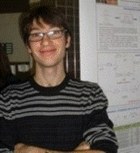
Michel Chiarucci
Post Doc 2013
Michel Chiarucci was born in Urbino in 1983. He received his PhD in Organic Chemistry in 2011 under the supervision of Prof. Marco Lombardo, at the University of Bologna. During his PhD studies he spent 5 months in the group of Prof. Oliver Reiser at the University of Regensburg.
In 2011 he obtained a postdoctoral fellowship in the research group of Prof. Marco Bandini at the Chemistry Department “G. Ciamician” at the University of Bologna, working on the development of gold-catalyzed stereoselective reactions.
In 2013 he joined the group of Prof. Andrea Mazzanti at the Industrial Chemistry Department “T. Montanari”, where his research focused on the application of spectroscopic and computational methodologies to the conformational study of organic molecule.
Since December 2014 he is researcher at Polycrystalline (Medicina, Italy) where his main activity is the disclosure of new salts and cocrystals of active pharmaceutical ingredients.
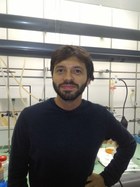
SIMONE CROTTI
PH.D. GRADUATE IN 2020
Chemical Science XXXII Cycle
Department of Industrial Chemistry "Toso Montanari"
Simone Crotti was born in Reggio Emilia. He received his MSc (110 cum laude) in Industrial Chemistry in 2016 from the University of Bologna, working on the Synthesis, SAR and cytotoxic evaluation of pyrazole-fused isoquinoline-5,8-diones as promising anticancer scaffolds, under the supervision of Prof. Mauro Comes Franchini. He is currently in his third PhD year with Prof. Paolo Righi. His research interests include vinylogous reactivity and atroposelective organocatalysis.
Thesis:
Organocatalytic Desymmetrization Reactions: Catalyst-Controlled Enantio-, Atropo- and Diastereotopic Group Selection for the Synthesis of Central and Axial Stereogenic Elements
Supervisor: Prof. Dr. Paolo Righi
Co-supervisor: Prof. Dr. Giorgio Bencivenni, Dr. Nicola Di Iorio
